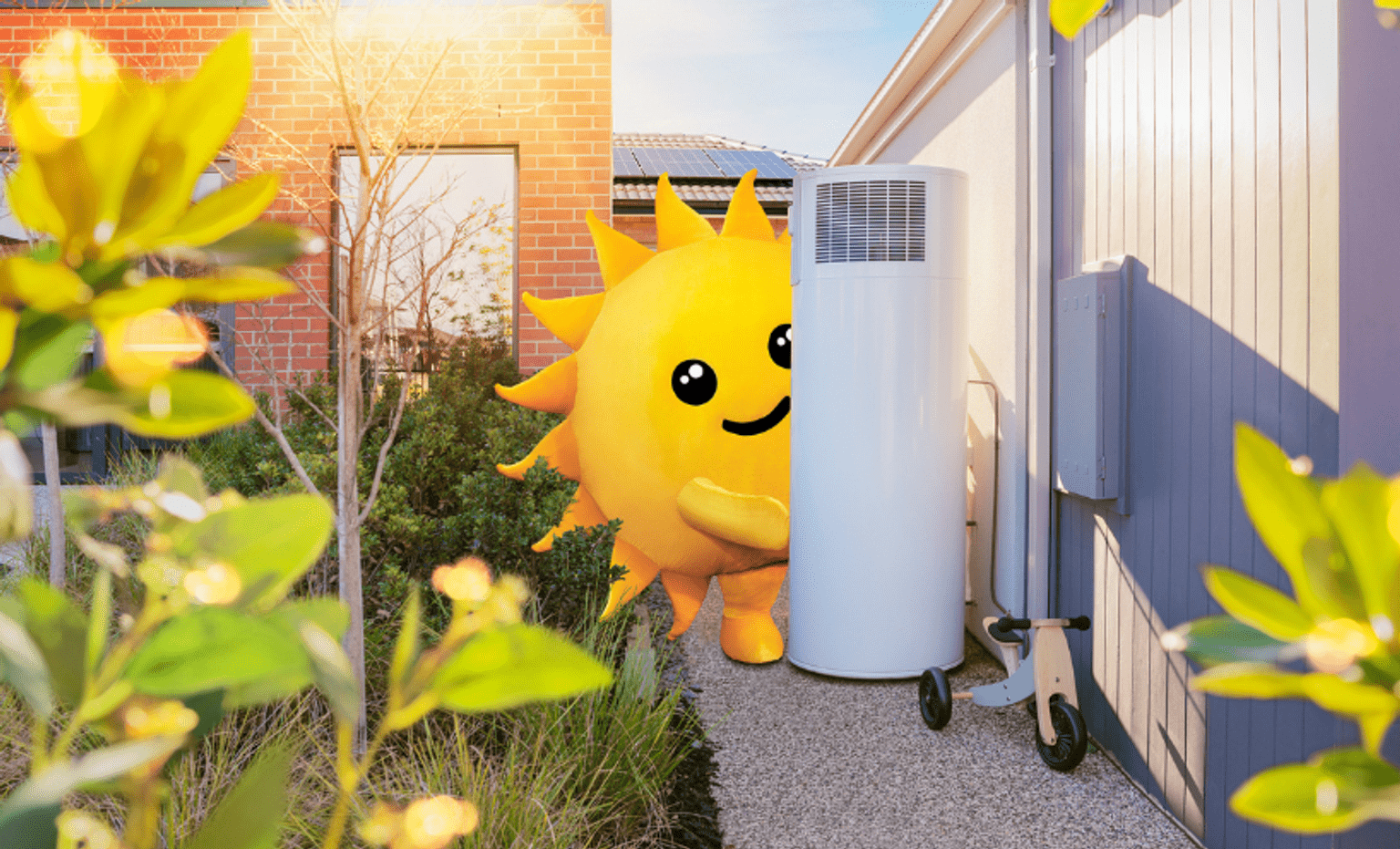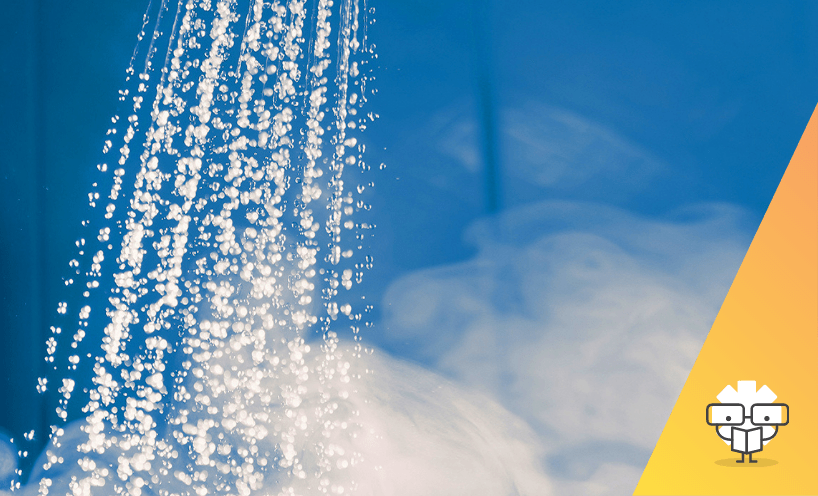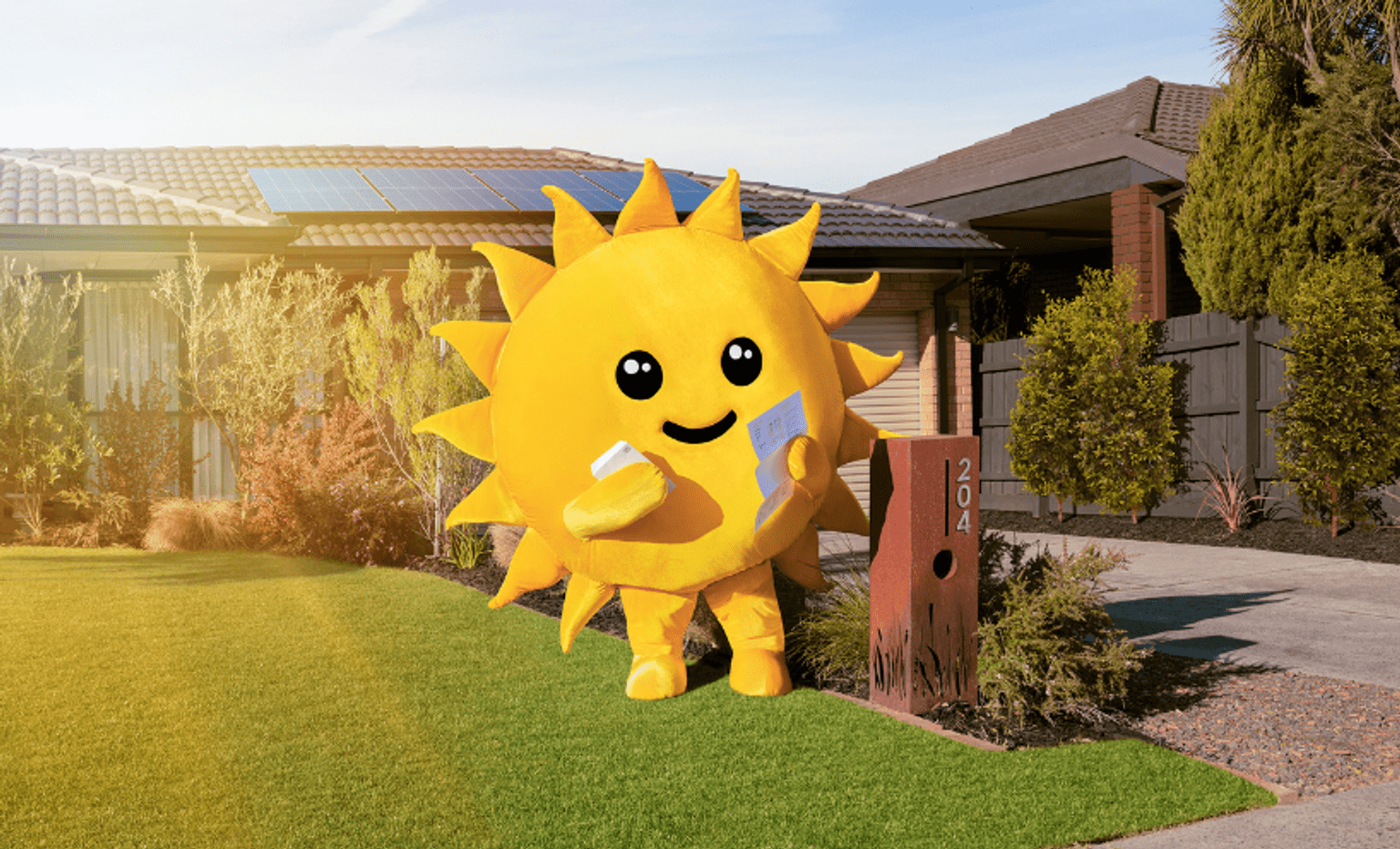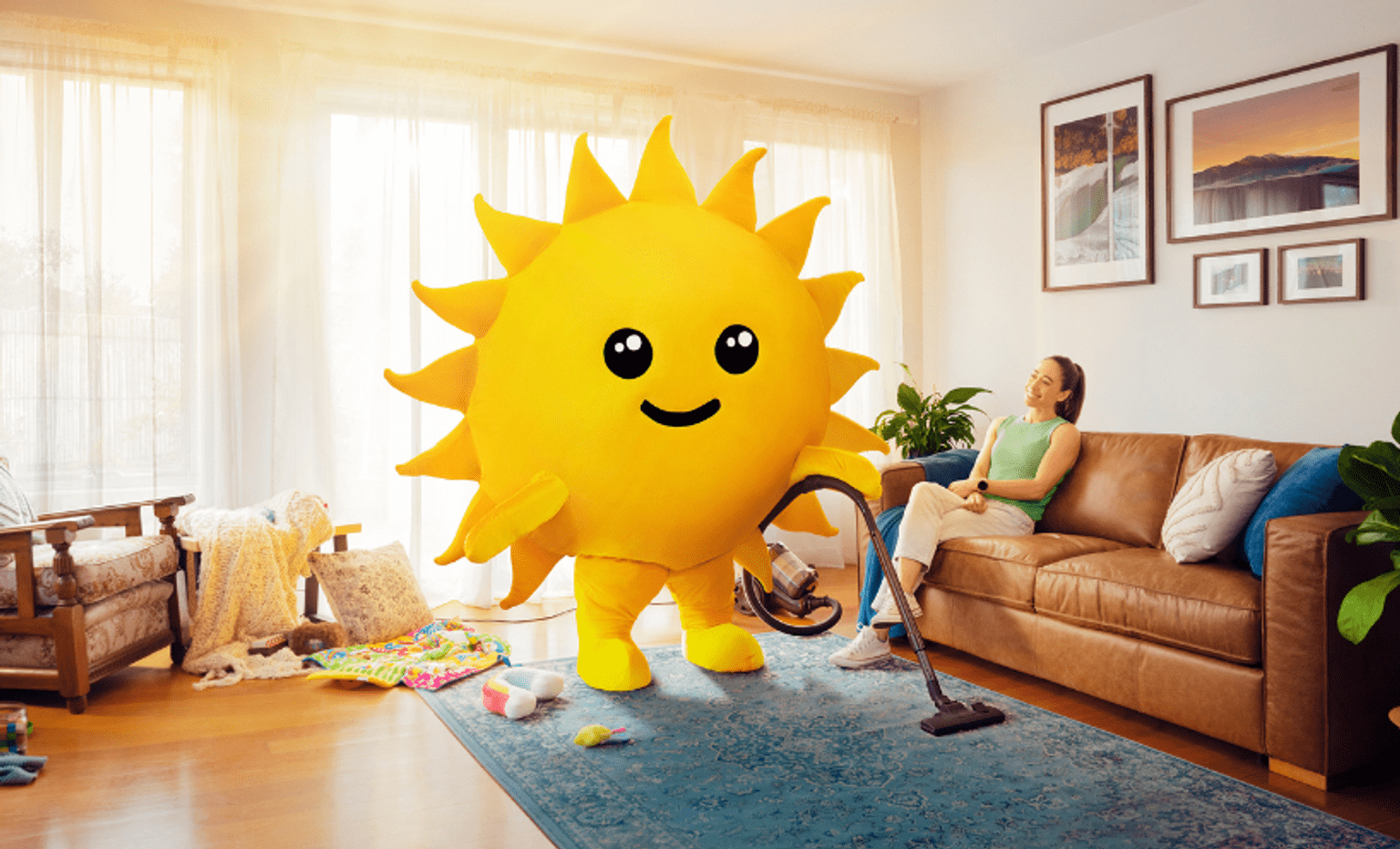- Date:
- 2 Oct 2020
A well-designed and properly installed hot water system can help lower your household bills. To get the most out of your system it needs to be planned and installed properly. Choose quality parts and components, and a reputable retailer and installer.
When you’ve found the right retailer and product for you, you can use their quote to begin applying for eligibility for a rebate.
Section 1: What is an efficient hot water system and why should I install one?
Solar energy is the most sustainable way to heat your water at home, saving you money and helping the environment at the same time.
There are two main ways to do it: solar hot water systems use direct solar energy to heat water, and heat pumps transfer heat from the air to heat the water, typically through an electric booster. Depending on your situation – such as where you live, whether you have solar panels, or how much hot water you use – one of these types of hot water system might suit your household more.
21% of household energy use can be attributed to hot water systems.
An efficient hot water system will help reduce your bills
Hot water systems are one of the biggest energy users in the home, accounting for around 21 per cent of total energy use (on average, according to YourHome) This can have a significant impact on household energy bills, but one way to keep these costs under control is to install an efficient hot water system such as a heat pump or solar hot water system.
What we consider to be an efficient hot water system has changed a lot in the last decade. Modern electric appliances such as heat pumps use less energy than gas appliances and can run on renewable energy. As more Victorian households install solar photovoltaic (PV) systems more people can take advantage of solar-generated electricity to bring down the cost of running the hot water system.
Each system installed helps the environment
Victorian households can help reduce greenhouse gas emissions by upgrading to a hot water system that uses less energy.
Depending on the type of heat pump hot water system installed, energy reductions of almost 80 per cent can be achieved compared to standard electric storage water heaters. Standard electric storage water heaters use a heating element inside the tank to heat the water, just like an electric kettle. When powered using electricity from the grid, they are responsible for the most greenhouse gases of any water heater and are being phased out for household use, not just in Victoria but around the country.
A solar hot water system uses the sun to heat the water, with any shortfall made up by electric or gas boosting. A solar hot water system can cover up to 60 per cent of your household hot water demand in Victoria before boosting is required, which is water heated without any grid energy use or associated greenhouse gas emissions.

Hot water rebate
Hot water rebates of up to $1,000 are available for eligible heat pump and solar hot water products. If you select a locally made product, you could be eligible for a rebate of up to $1,400.
Section 2: What rebates and incentives are available to Victorians for efficient hot water systems
You can get a Solar Homes rebate of up to $1,000 on the installation of a solar or heat pump hot water system, if you meet the eligibility criteria.
Hot Water Rebate
You can get a hot water rebate of up to $1,000 on the installation of a solar or heat pump hot water system, if you meet the eligibility criteria.
The hot water rebate applies to installations that replace an existing hot water system that was at least three years old (from the date of purchase) and it’s not available to new build homes.
The Solar Homes Program is supporting eligible Victorian households to save even more. Eligible households can receive both a solar panel (PV) rebate and a hot water rebate to make the most of their solar energy.
If you have received a solar battery rebate, you cannot apply for a solar panel (PV) or a hot water rebate for your home. Visit our Solar Homes Program rebate pages to see if you are eligible for a rebate.
The Victorian Government's Energy Saver website provides householders with more information about other incentive schemes.
Small-scale Technology Certificates (STCs)
Your new system is also eligible for Small-scale Technology Certificates (STCs). This is effectively a payment made to purchasers of small renewable energy systems for the value of the emissions reduction they create. The quoted price of the system from your installer will have the STC discount included in the final price.
Victorian Energy Efficiency Certificates (VEECs)
Victorian Energy Efficiency Certificates (VEECs) are electronic certificates created when certain energy efficient activities are undertaken. Each certificate represents one tonne of greenhouse gas emissions reduction (CO2-e). The number of certificates generated is based on the greenhouse gas savings that are associated with the product or service. The level of incentive or discount received by households and businesses varies depending on the market activity and certificate price. More information about VEECs can be found at energy.vic.gov.au.
Section 3: Choosing between a heat pump and solar hot water system
A hot water system is a big investment and one that won’t be replaced too frequently, so a household should weigh up the differences between a heat pump and solar hot water system.
In this section we discuss the two main types of efficient hot water system to help you decide which best suits your needs. Look here for further detail: Planning a solar hot water system and Planning a heat pump hot water system.
What is a heat pump hot water system and how does it work?
Air conditioners and refrigerators are two common forms of heat pumps that you might be familiar with. They work by moving or ‘pumping’ heat from one medium to another. For example, your fridge extracts heat from its freezer section and pumps warm air out the back.
A heat pump hot water system includes a heat pump unit, like the outdoor unit for a split-system air conditioner, and a storage tank. The heat pump extracts heat from the air and pumps it into the water storage tank. Good heat pumps can do this effectively even in freezing weather.
Heat pump hot water systems are much more efficient than standard electric water heaters, although the electricity for the unit is still supplied via your normal household electricity wiring or your solar panels.
What is a solar hot water system and how does it work?
A solar hot water system uses heat directly from the sun to heat water. A typical system consists of a hot water storage tank connected via pipework to solar collector panels or evacuated tubes, which heat the water for the tank. Both system types are usually placed on a north-facing roof, although a west-facing roof can also work well in many cases.
As the sun shines on a collector panel, the water in the pipes inside the collector becomes hot. This heated water is circulated up the collector and out through a pipe to the storage tank. Cooler water from the bottom of the tank is then returned to the bottom of the collector, replacing the warmer water.
Deciding between a solar or heat pump hot water system
Consider the environmental benefits of a system, how a water heater works with the existing power supply, the upfront cost and the cost to run, along with other factors such as reliability.
Differences between heat pump and solar hot water systems
Each type of system has advantages and disadvantages:
Choosing a reliable hot water system
When you choose a hot water system, you want a reliable unit that will last.
Solar hot water systems have complex installation requirements, so it’s crucial that you use a highly experienced and accredited installer.
Heat pumps are more complex internally, so a quality design and manufactured product will be important. Talk to your retailer about a trusted brand and model.
Whichever type of system you choose, a trusted installer and a reputable brand and model will reduce the likelihood of problems down the track. Make sure you also check warranty details.
Make sure you do your homework early, before a cold shower forces a snap decision!
How can I make the most or improve of my current system?
The simplest option may be to improve the efficiency of an existing system rather than buy a new one. Improvements can include:
- If you haven't already done so, install low-flow shower heads and aerating taps to reduce hot water requirements
- Check that the hot water pipes are properly insulated (to reduce heat loss) and improve the insulation where necessary
- If you have a storage hot water system (i.e. with a tank):
- Add a Valve Cosy to insulate the pressure and temperature relief valve (valvecosy.com.au)
- Add a tank blanket or other insulation to your water tank
- Adjust the tank’s temperature control to reduce tank temperature if it’s set too high, noting that it should not be less than 60°C for biosafety reasons (to prevent the growth of Legionella bacteria). Some tanks require an electrician to check and adjust temperature
This advice can even improve the performance of new systems.
Section 4: Deciding your hot water system size and tank
System size has an impact on energy use so think carefully about what your household needs from a new hot water system.
What size system suits your household?
Working out the right size for your new hot water system is one of the most important aspects of system selection. Sizing is a trade-off between cost and performance, and a key element of performance is the level of risk of running out of hot water!
The system should be sized for the dwelling, not necessarily its occupants. People sell houses and move on, but the hot water system stays.
It is generally accepted that each person will use around 50 litres of hot water per day, and in a storage system it is good to have 1.5 days capacity. A three-bedroom house can comfortably accommodate four people and so it should have a 300-litre tank, even though it may currently be occupied by a retired couple.
Also think about whether the dishwasher and washing machine need plumbed hot water. These appliances often include in-device water heating these days, which reduces household hot water storage requirements.
What type of tank should I consider?
A mains pressure tank is common for both solar and heat pump hot water systems.
Section 5: Planning a solar hot water system
There are a number of system types and factors to consider when planning a solar hot water system. See Section 4 for details on system sizing and tanks for all hot water systems. Read on for specific advice on solar hot water systems.
Split and close-coupled systems explained
Collector types
There are two common types of solar hot water collector panels: flat-plate and evacuated-tube. Which type of collector you use depends on personal preference and your climate. Evacuated tubes tend to work better in the cooler months in colder climates, but in warmer climates, either type of collector will perform well. Evacuated tubes can also be up to 163% more efficient.
Boosting
Virtually all hot water systems on the market incorporate some form of boosting.
Electric elements are the most common boosting option. They fit in well with cheaper night rate tariffs. If you have a solar panel (PV) system installed then this might help reduce energy costs associated with boosting.
Frost protection
The system should be fitted with a freeze protection system if frosts are a possibility in your area. Water expands as it turns into ice and if there is no ability to absorb this expansion or prevent it happening, then the result will be ruptured pipes in the collectors. Repairing collectors can be difficult and replacement is expensive.
All manufacturers offer frost protection on at least some models.
Temperature control
Solar hot water systems are effectively connected to an uncontrolled heat source (the sun) and so the temperature in the tank may become much higher than in a regular non-solar water heater.
In hot weather, with minimal hot water use, tanks could actually reach boiling point. A number of mechanisms can be used to prevent this from happening, include pressure and temperature relief (PTR) valves, heat dumps, circulation control increasing the collector slope at insulation time and tempering valves.
Installation considerations for solar hot water systems
Installation methods will vary depending on the type of system chosen, the house roof angle and structure and the location and orientation of the home.
All water pipes should be insulated to reduced heat loss and to minimise or eliminate frost damage.
Section 6: Planning a heat pump hot water system
A heat pump hot water system can be a great choice for many households, especially if you have rooftop solar PV, or don’t have a gas connection.
See Section 4 for details on system sizing and tanks for all hot water systems, and read on for advice on heat pump hot water systems.
Integrated and split systems explained
Like solar systems, heat pump hot water systems are configured as either one-piece (integrated) or split. In an integrated system, the evaporator and fan are mounted on top of or beside the tank and integrated into a single unit.
In a split system, the heat pump mechanism is housed in a separate unit plumbed to the tank at installation time.
An integrated unit has the benefits of simpler installation and compactness, whereas a split-system unit allows greater flexibility in locating the two components. For example, you could locate the tank indoors and the heat pump mechanism outside on a wall. Integrated heat pumps weigh more so could take two people to move or install.
Boosting
Heat pumps are designed to run whenever the tank temperature falls below a pre-set level (e.g. 60°C). Some heat pumps struggle in air temperatures approaching freezing, and so may use a resistive electric element as a booster in these conditions. This can end up using quite a bit of extra energy, leading to higher running costs. If you live in an area that sees regular near-freezing temperatures, look for a system that will operate under such conditions without the need for a resistive booster. Plenty of these systems are on the market, you’ll just need to do some research or chat to your installer.
Some heat pumps also come with a timer, so that it operates during the middle of the day, using solar panel (PV) generated electricity (if you have it) and benefitting from higher daytime ambient temperatures.
Not all heat pumps have timers, however if you want to make the most of your solar panels (PV) you should consider a heat pump that includes an in-built timer or ideally can communicate with your solar panel (PV) system to optimise your solar generation.
However, extra hot water may be needed at other times, so most timers have the ability to be overridden for just such requirements.
Noise
Being refrigerative systems with compressors and fans, heat pumps make some noise, although some are noisier than others. Reported noise levels are comparable to modern refrigerators. Avoid fitting the condenser close to bedrooms unless they’re on a timer and only run during the day.
Noise is perhaps slightly more of a consideration for a heat pump hot water system than for an air conditioner because use is year-round and heating operation can engage at any time of the night or day.
With systems that have a controller that can be programmed to heat at certain times of the day, the ability to restrict time of operation may be useful if noise is a concern.
Select an appropriate location to install a system. For example, outside a kitchen or bathroom might be more appropriate than outside a bedroom.
Installation considerations for heat pump hot water systems
The installation of a heat pump hot water system requires less work than a solar hot water installation, and the location of the equipment is much less sensitive to local factors such as shading and roof access.
An electrician is required to install the electric circuit for the hot water service. If the heat pump is replacing an existing conventional electric system then the plumbing and electrics should be no more difficult than for replacing a new conventional system.
All water pipes should be insulated to reduce heat loss and to minimise or eliminate frost damage.
Section 7: Finding the right installer and steps to installation
A good installer can help you plan a hot water system for your home that’s sized for your needs and helps lower your bills for many years to come. Follow these steps to install a hot water system.
Steps to purchase and install a hot water system at home
- Read this Buyers Guide to learn about hot water systems. Gather your questions and seek independent advice
- Confirm your own household’s requirements – see Section 4 on Deciding your hot water system size and tank
- Seek recommendations on installers or companies that manage installation, and then contact those who are appropriately accredited for quotes
- Select your preferred installer. Make sure the quote meets your needs. Using our checklists can help
- Apply for the hot water rebate
- Sign a contract with your installer
- Install your new system
- Enjoy your new hot water system and reduced energy bills
Finding a retailer or installer
The installation of any hot water system should be carried out by appropriately qualified and experienced tradespeople to make sure it is properly sized and installed. Only authorised retailers, installers and products on our hot water products list are eligible under the hot water rebate program. See our authorised hot water retailer list.
Solar Victoria has guidelines for the installation of hot water systems to be eligible for the hot water rebate.
All hot water installations must be completed by:
- an appropriately licensed plumber and a Plumbing Certificate of Compliance must be supplied to the householder.
- an installer that holds a current Class A Electrical Licence issued by Energy Safe Victoria if prescribed electrical installation work is required.
- an electrician who can submit a prescribed Certificate of Electrical Safety to the householder, which has been certified by a licensed inspector registered with Energy Safe Victoria.
- a hot water retailer who can provide a minimum five years’ warranty on all major components of your hot water system.
The system installed also needs to be included in our hot water product list. All installers must ensure safe work methods and fall prevention measures are in place as per the Occupational Health & Safety Regulations 2017 (S.R No. 22/17). Find full details on the Hot Water rebate page.
Getting a quote
Your retailer or installer should provide you with a written quote for a product that is included on the hot water product list. Remember when you seek out a quote for your hot water system installation you should advise your retailer you intend to apply for the rebate.
You should ask about the maintenance and operation requirements of your system, and don’t be rushed into making a decision.
Consider how system faults will be handled
A warranty is only as good as the company that provides it. If the company disappears in a few years, you might have difficulty making a warranty claim should failures occur. Seeking out a retailer or installer with a long history in the business helps.
Also, be aware that under Australian Consumer Law, warranties are required to be honoured by product manufacturers even if retailers have gone out of business, so make sure you receive and keep information about the manufacturers of all the different components of your system, and the different warranties on each component. See What warranties are available for more information.
What not to do when engaging an installer or company
Don’t buy a hot water system from a door-to-door salesperson, or from a salesperson who cold calls you on the phone. If you have signed a contract in this way, take advantage of the 10-day cooling off period under consumer law to cancel the contract, and then take your time to do your homework, plan your system and find a quality installer.
If you are applying for the Hot Water rebate, don’t make any payment to a hot water provider until your eligibility for the rebate has been confirmed by Solar Victoria. Apply for eligibility on the hot water rebate page.
Scams do exist unfortunately, with offers that appear to be too good to be true. Visit the ACCC’s SCAMwatch website for more information on protecting yourself from scams.
If you are the target of a scam, please report it to the Australian Competition and Consumer Commission (ACCC) via the SCAMwatch website or by calling 1300 795 995.
Installer and quotation checklist
It’s best to sound out an installer to check their reliability before handing over your hard-earned cash. Have they successfully installed this particular hot water system before? What happens if they go out of business? Here are some key questions to get you started.
General questions regarding all systems
- What’s your experience with heat pumps/solar hot water systems?
- Are you licensed to install this kind of system?
- What happens if the system needs to be fixed under warranty, and your business is no longer operating?
- How long have the equipment manufacturers been in the industry, and do they have a local office?
- What’s the warranty on the tank? And on the other components of the hot water system?
- Does the quote include all system components as well as installation?
- Does the quote include all labour, transportation and inspection charges?
- What maintenance is required on the system?
- What subsidies does my system qualify for?
- Are the products on Solar Victoria’s hot water products list?
- Are replacement parts readily available?
- How long can I expect my system to last?
- How long will it take to install the system?
- How many STCs does my system qualify for?
- What material is the tank?
- Will the installation be designed to reduce weathering of the storage tank?
- What level of insulation and lagging do you offer on the system? Do you install measures to prevent heat coming out of the pressure relief valve?
- What is the maximum output water temperature and is a tempering valve included? Note: tempering valves are compulsory.
- Will the system meet the household’s needs regarding number of occupants and bathrooms?
- If you’re looking at an electric hot water system, ask if they can set up a timer so that it runs in the middle of the night, or in the middle of the day if you have a solar electricity system.
Questions for heat pump installers
It’s important to differentiate between high quality heat pumps and those that are less efficient. The ‘coefficient of performance’ (COP) is a measurement of how much energy a heat pump can draw from the air, for each unit of electricity it consumes. A heat pump with a COP of 2 produces twice as much energy as it uses, while one with a COP of 4 produces four times as much. The best heat pumps will have a coefficient of performance of 3.5 to 4 or higher, while some of the lesser quality heat pumps may be down at 2 to 2.5.
You can also check the percentage of energy savings on the VEU Product Registry.
Some installers will also tell you that heat pumps don’t work in cold weather. In fact, some brands don’t work very well in the cold, while others work quite well. (Heat pumps are common in northern Europe where below-zero temperatures are quite common in winter.)
Here are some questions to help pick a quality heat pump:
- What’s the heat pump’s coefficient of performance?
- What is the heat pump’s coldest operating conditions, or operating temperature range?
- What is the heat pump’s noise rating? Does the compressor have a block out timer/timing function?
- Does the heat pump have a resistive element? (If so, it could mean that the actual heat pump doesn’t work as well as others. You’d also need to be wary of what impact the resistive element could have on household electricity use.)
- What is the tank warranty, compressor warranty and installation/workmanship warranty
- What’s the process to enact a tank or compressor warranty after the installation warranty has expired?
- Are there any additional costs such as safety switch costs, set up for block out timing (to match solar PV generation times), or extra cost for an elevated work platform?
Questions for solar hot water installers
Solar hot water systems can take a number of days to install due to the plumbing and roof-work involved. Quiz your installer about the full installation process.
- How well does the system perform in overcast conditions?
- How long will it take to install the complete system?
- Will my system need a tilt frame?
- Does the system come with freeze protection?
- Will my roof need to be strengthened for a close-coupled system?
- What is the tank, collector, booster and installation warranty?
Section 8: What warranties are available?
Any hot water system worth buying will come with a long warranty. There are several warranty types to consider.
Warranties and standards on solar hot water systems
The warranties offered on solar hot water systems vary from one manufacturer to another and should be carefully scrutinised when buying a system. Generally, the tanks (and collector panels for solar hot water systems) are warranted for five to ten years while the associated valve work will carry a 12-month warranty only. Read the warranty conditions carefully, especially those concerning labour. Some warranties are conditional on installation by appropriately qualified personnel, regular servicing and water quality.
All Australian systems are built to a set of standards outlined by Standards Australia. These cover design, construction and performance. Installation standards are covered in the National Plumbing and Drainage Code AS 3500.4. Manufacturers are now part of a quality control system for all water heaters under AS 3498, also known as the Watermark. After successfully undergoing an assessment process, manufacturers are entitled to attach the Watermark to their products and promotional material.
Warranties and standards on heat pump hot water systems
Check that the heat pump has a generous warranty of at least 5 years, and that prompt service is available in your area. This is perhaps more of an issue than with traditional hot water systems as the units are less common and their maintenance is slightly more specialised.
Section 9: Consumer protections when buying solar or hot water systems
If you have a problem with a solar electricity or hot water system installed at your home you have rights to protect you as a consumer.
You have rights to protect you as a consumer if you have a problem with a solar hot water or heat pump system installed in your home. This includes the rights you have under Australian Consumer Law.
Your consumer rights
Australian Consumer Law has rules for responsible marketing and selling, products being fit for purpose, and warranties being honoured.
When you buy a system find out who you should contact if there is a fault, and be aware of the warranties available with your system.
If you have a problem with a product, service or unfulfilled contract try to resolve it directly with your retailer first. Putting your complaint in writing gives you records of your dealings with it.
If you are unable to contact the business, or you do not receive a satisfactory response within a reasonable time, you could lodge a complaint with Consumer Affairs Victoria, who may be able to assist.
The Solar Energy page on the Consumer Affairs Victoria website has advice on the next steps, from dealing with a faulty product such as a solar inverter, problems with installation and dealing with insolvent businesses.
You may also choose to take your complaint further by applying to a court or tribunal, such as the Victorian Civil and Administrative Tribunal (VCAT), or seek your own independent legal advice.
More information, including who to contact about your rights as a consumer, see Consumer protection.
Ensuring safety in the Solar Homes Program
The Solar Homes Program requires the highest standards in safety, which is the responsibility of workers and their employers who must ensure their teams are trained, supervised and equipped to do the job safely.
Solar Victoria is working with a range of agencies to minimise risk to works and householders getting new solar installations.
WorkSafe Victoria and Energy Safe Victoria are conducting inspections at the time of installation. Independent post-installation audits commissioned by Solar Victoria are underway.
The post installation auditing process assesses electrical safety, confirms the equipment installed is what was quoted for, and that the installer was approved by the Clean Energy Council to do the work. It also confirms that the inspection by the Licensed Electrical lnspector was done correctly.
An enforcement committee made up of various regulators (WorkSafe Victoria, Energy Safe Victoria, Consumer Affairs Victoria, Victorian Building Authority) and the Clean Energy Council reviews each matter to determine if further action is needed.





